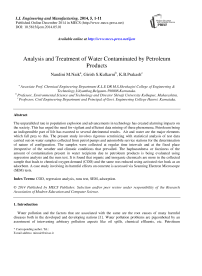Analysis and Treatment of Water Contaminated by Petroleum Products
Автор: Nandini M.Naik, Girish S.Kulkarni, K.B.Prakash
Журнал: International Journal of Engineering and Manufacturing(IJEM) @ijem
Статья в выпуске: 5 vol.4, 2014 года.
Бесплатный доступ
The unparalleled rate in population explosion and advancements in technology has created alarming impacts on the society. This has urged the need for vigilant and efficient data mining of these phenomena. Petroleum being an indispensible part of life has escorted to several detrimental results. Air and water are the major elements which fall prey to this. The present study involves rigorous scrutinizing with statistical analysis of test data carried out on water samples collected from petrol pumps and automobile service stations for the determination of nature of configuration. The samples were collected at regular time intervals and at the fixed place irrespective of the weather and climatic conditions that prevailed. The haphazardness or fuzziness of the amount of contamination present in water recipients due to petroleum products is being evaluated using regression analysis and the runs test. It is found that organic and inorganic chemicals are more in the collected sample that leads to chemical oxygen demand (COD) and the same was reduced using activated rice husk as an adsorbent. A case study involving its harmful effects on concrete is accessed via Scanning Electron Microscope (SEM) tests.
COD, regression analysis, runs test, SEM, adsorption
Короткий адрес: https://sciup.org/15014371
IDR: 15014371
Список литературы Analysis and Treatment of Water Contaminated by Petroleum Products
- Adebayo P. Idowu., et al " Development of a Web Based Environmental Health Tracking System for Nigeria" I.J. Information Technology and Computer Science, 2012, 7, 61-71 Published Online July 2012 in MECS. DOI: 0.5815/ijitcs.2012.07.08.
- Sun Ying., "The Utilization of Escherichia Coli-based Magnetic Nanobeads as An Ultrasensitive Biosensor for Mercucy, I.J. Engineering and Manufacturing 2011, 3, 50-54, MECS. DOI: 10.5815/ijem.2011.03.08.
- H. Abu Qdaisa and H. Moussab, "Removal of heavy metals from wastewater by membrane processes: a comparative study," Desalination. USA, vol. 164, 2004, pp. 105–110.
- W.C. Leung, M.F. Wong, H. Chua, W. Lo and C.K. Leung, "Removal and recovery of heavy metals by bacteria isolated from activated sludge treating industrial effluents and municipal wastewater," Water Sci. Technol. Eng., vol. 41, (2000), pp. 233–240.
- Zhang, Xiaodong, Guo H. Huang, Qianguo Lin, and Hui Yu. "Petroleum contaminated groundwater remediation systems design: A data envelopment analysis based approach." Expert Systems with Applications 36, no. 3 (2009):5666-5672.Elsevier, DOI: 0.1016/j.eswa.2008.06.136.
- Lopez et al, "Human health risks of petroleum-contaminated groundwater", Spain.
- Crini, Gregorio. "Non-conventional low-cost adsorbents for dye removal: a review." Bioresource technology 97, no. 9 (2006): 1061-1085. Elsevier. DOI:10.1016/j.biortech.2005.05.001.
- Klas Persson, Georgia Destouni, "Propagation of water pollution uncertainty and risk from the subsurface to the surface water system of a catchment", Journal of Hydrology 377 (2009) 434–444, Elsevier. DOI: 10.1016/j.jhydrol.2009.09.001.
- Subinal Ghosh and P.P. Mujumdar, "A Fuzzy Waste Load Allocation Model Integrating Skewness of Distributions".
- Subimal Ghosh, P.P.Mujumdar, "Minimization of constraint violation in fuzzy multi objective programming", 7th International Conference on Hydro informatics, HIC 2006, Nice, France, 7th International Conference on Hydro informatics.
- Christian Baresal, "Environmental management of water systems under uncertainty", Doctoral Thesis, Stockholm, Sweden 2007.
- V.R. Subbarao Vemula, P.P. Mujumdar, Subimal Ghosh,"Risk evaluation in water quality management of a river system".
- Sameer V, Yamakanamardi et al, "Assessment of chloride concentration in groundwater: A case study for Belgaum City", International journal of environmental sciences, Volume 2, No 1, 2011.
- Piscopo, Antoine, Didier Robert, and Jean Victor Weber. "Influence of pH and chloride anion on the photo catalytic degradation of organic compounds: Part I. Effect on the benzamide and para-hydroxybenzoic acid in TiO2 aqueous solution." Applied Catalysis B: Environmental 35, no. 2 (2001): 117-124. Elsevier. PII: S0926-3373(01)00244-2.
- Xagoraraki, I., and D. Kuo. "Water pollution: Emerging contaminants associated with drinking water." International Encyclopedia of Public Health 6 (2008): 539-550. Elsevier.
- Sarwade et al., (2008). "Assessment of groundwater quality in urban area, Belgaum city, Karnataka, India", Journal of Applied Geochemistry, 10(2), pp 148¬ 165.
- Camargo, Julio A., and Álvaro Alonso. "Ecological and toxicological effects of inorganic nitrogen pollution in aquatic ecosystems: a global assessment." Environment international 32, no. 6 (2006): 831-849. Elsevier. DOI:10.1016/j.envint.2006.05.002.
- Boyd, Claude E., and Laurence Massaut. "Risks associated with the use of chemicals in pond aquaculture." Aquacultural Engineering 20, no. 2 (1999): 113-132. Elsevier.
- APHA, "Standard methods for the examination of water and wastewater", American Public Health Association, Washington D.C, (1985). PII: S0144-8609(99)00010-2.
- Mohan, Dinesh, Kunwar P. Singh, and Vinod K. Singh. "Wastewater treatment using low cost activated carbons derived from agricultural byproducts—a case study." Journal of Hazardous materials 152, no. 3 (2008): 1045-1053. DOI: 10.1016/j.jhazmat.2007.07.079.
- Bhatnagar, Amit, Eva Kumar, and Mika Sillanpää. "Fluoride removal from water by adsorption—a review." Chemical Engineering Journal 171, no. 3 (2011): 811-840. Elsevier. DOI: 10.1016/j.cej.2011.05.02.
- Ali Hashem et al, "Bio adsorption of Cd (II) from Contaminated Water on Treated Sawdust: Adsorption Mechanism and Optimization" Journal of Water Resource and Protection, 2013, 5, 82-90. Doi:10.4236/jwarp.2013.51010.
- ADEMILUYI, F. T et al "Adsorption and Treatment of Organic Contaminants using Activated Carbon from Waste Nigerian Bamboo". J. Appl. Sci. Environ. Manage. September, 2009 Vol. 13(3) 39 – 47.


